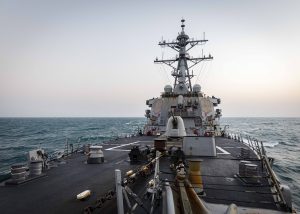The United States Navy conducted its first freedom of navigation operation (FONOP) under the new Biden administration on February 5. According to a U.S. 7th Fleet Public Affairs release, the Arleigh Burke-class guided-missile destroyer USS John S. McCain carried out a FONOP near the disputed Paracel Islands in the South China Sea in order to uphold the right of innocent passage, including for naval vessels, in face of restrictions imposed by China, Taiwan, and Vietnam, the three countries that claim sovereignty over the islands.
According to the press release, the McCain’s FONOP was also designed to challenge China’s 1996 declaration of straight baselines around the islands in contravention to Article 7 of the United Nations Convention for the Law of the Sea (UNCLOS). The United States maintains — as reiterated in the February 5 7th Fleet statement — that these baselines allow China to make excessive claims about “internal waters, territorial sea, exclusive economic zone, and continental shelf,” beyond what is allowed under UNCLOS.
“Unlawful and sweeping maritime claims in the South China Sea pose a serious threat to the freedom of the sea, including freedoms of navigation and overflight, free trade and unimpeded commerce, and freedom of economic opportunity for South China Sea littoral nations,” the statement noted.
“By engaging in innocent passage without giving prior notification to or asking permission from any of the claimants, the United States challenged these unlawful restrictions imposed by China, Taiwan, and Vietnam. The United States demonstrated that innocent passage may not be subject to such restrictions,” it said by way of explaining one of the two objectives behind the FONOP.
The day before, on February 4, the McCain transited the Taiwan Strait in an operation described by the 7th Fleet as “routine.” A press statement from the fleet on that occasion noted that the “ship’s transit through the Taiwan Strait demonstrates the U.S. commitment to a free and open Indo-Pacific.” Media reports about the destroyer’s Taiwan Strait transit have noted that it was seen operating in the vicinity of two People’s Liberation Army Navy guided-missile frigates.
According to a database maintained by S. Rajaratnam School of International Studies maritime researcher Collin Koh, between October and December last year, the McCain had carried out four FONOPs in the South China Sea, two of which were also in the vicinity of the Paracel Islands. Another database that Koh maintains that tracks transits of U.S. naval ships through the Taiwan Strait noted that between October and December, four such passages took place, one of which (on December 31) involved the McCain along with another destroyer, USS Curtis Wilbur.
In the run-up to the inauguration of Joe Biden as president of the United States last month, analysts – not the least, in Asia – had widely speculated that he might adopt a more conciliatory tone toward China, and trade a robust American position on Chinese territorial revisionism in the South China Sea and elsewhere for cooperation on climate change and other global governance issues. The February 5 FONOP by the McCain forms the first concrete data point in indicating that Biden’s South China Sea policy is likely to be substantively similar to his predecessor’s.

































